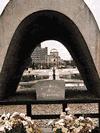- Hiroshima
-
/hear'oh shee"meuh, hi roh"sheuh meuh/; Japn. /hee"rddaw shee"mah/, n.a seaport on SW Honshu, in SW Japan: first military use of atomic bomb August 6, 1945. 899,394.
* * *
Founded as a castle town in the 16th century, it was from 1868 a military centre. In 1945 it became the first city ever to be struck by an atomic bomb, dropped by the U.S. in the last days of World War II. Rebuilding began in 1950, and Hiroshima is now the largest industrial city in the region. It has become a spiritual centre of the peace movement to ban nuclear weapons; Peace Memorial Park is dedicated to those killed by the bomb, and Atomic Bomb Memorial Dome is the ruin of the only building to survive the blast. Cenotaph in Peace Memorial Park, Hiroshima, Japan; Atomic Bomb Dome is visible through the arch.Bob GlazeArtstreet
Cenotaph in Peace Memorial Park, Hiroshima, Japan; Atomic Bomb Dome is visible through the arch.Bob GlazeArtstreet* * *
▪ Japancity and capital of Hiroshima ken (prefecture), southwestern Honshu, Japan, on Hiroshima Bay of the Inland Sea. The city is situated on the delta of the Ōta River, whose six channels divide it into several islets. Hiroshima, whose name means “Broad Island,” was founded as a castle town by the feudal lord Mōri Terumoto (Mōri Family) in the 16th century. From 1868 onward it was a military centre, and on Aug. 6, 1945, it became the first city in the world to be struck by an atomic bomb (nuclear weapon), which was dropped by a B-29 bomber of the U.S. Air Forces. Most of the city was destroyed, and estimates of the number killed outright or shortly after the blast have ranged upward from 70,000. Deaths from radiation injury (radiation) have mounted through the years.Reconstruction under a comprehensive city-planning scheme was begun about 1950 with the rebuilding of the Inari Bridge. Now the largest industrial city in that section of Japan encompassed by the Chūgoku (western Honshu) and Shikoku regions, Hiroshima contains many administrative offices, public-utility centres, and colleges and universities. Industries produce steel, automobiles, rubber, chemicals, ships, and transport machinery. The city is Japan's major needle producer.Hiroshima has become a spiritual centre of the peace movement for the banning of nuclear weapons. In 1947 the Atomic Bomb Casualty Commission (since 1975 the Radiation Effects Research Foundation) began to conduct medical and biological research on the effects of radiation in Hiroshima. Five public hospitals and 40 private clinics give free treatment to victims of the bombing. Hiroshima Castle was restored in 1957 and houses a museum of city history. Peace Memorial Park, located at the epicentre of the atomic blast, contains a museum and monuments dedicated to those killed by the explosion. The cenotaph for victims of the bombing is shaped like an enormous saddle, resembling the small clay saddles placed in ancient Japanese tombs; it contains a stone chest with a scroll listing the names of those killed. A commemorative service is held at the park every August 6th. The museum and cenotaph were designed by the Japanese architect Tange Kenzō, and two peace bridges at the park were sculpted by the American artist Isamu Noguchi (Noguchi, Isamu). Millions of paper cranes, the Japanese symbol of longevity and happiness, are heaped about the Children's Peace Memorial throughout the year; this tradition was inspired by a 12-year-old girl who contracted leukemia and died as an aftereffect of the bombing. Atomic Bomb Dome (Genbaku dōmu), which was designated a World Heritage site in 1996, is the remains of one of the few buildings not obliterated by the blast. Pop. (2005) 1,154,391.▪ prefecture, Japanken (prefecture), southwestern Honshu, occupying an area of 3,269 square miles (8,467 square km). The Chūgoku Mountains run along the northern boundary, and delta plains are extensively developed along the Inland Sea in the south. Agriculture (rice, oranges, chrysanthemums, rushes, and cattle) supports most of the population. There are shipyards at Kure and Onomichi and on Inno Island. The prefecture encompasses several offshore islands, including Itsuku Island (also called Miya), noted for the Itsuku Island Shrine and other shrines. Pop. (2003 est.) 2,878,000.* * *
Universalium. 2010.
